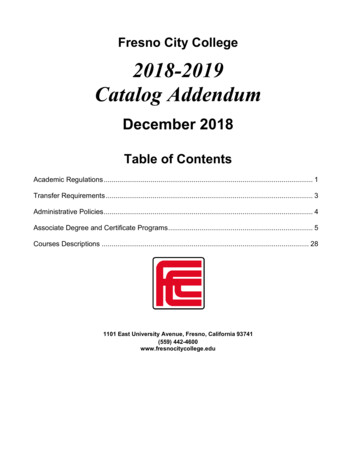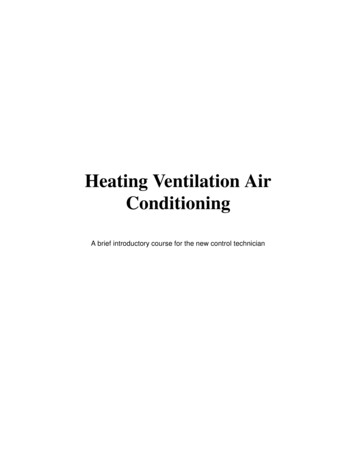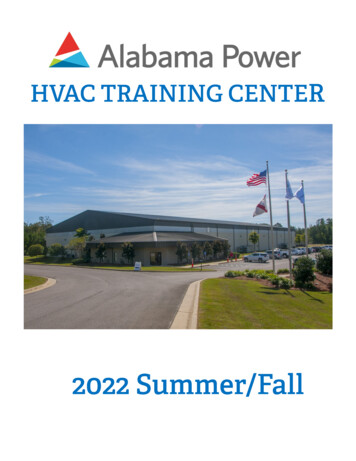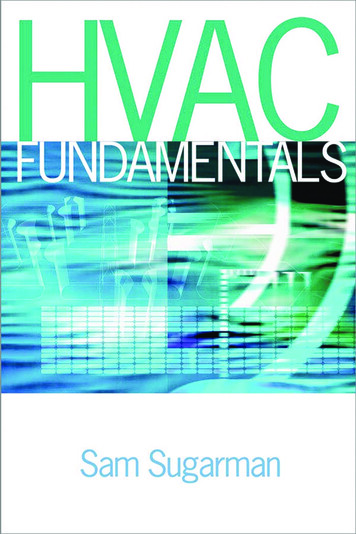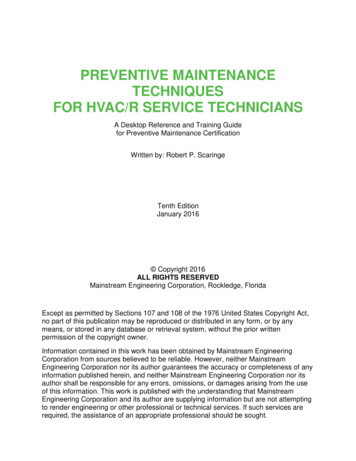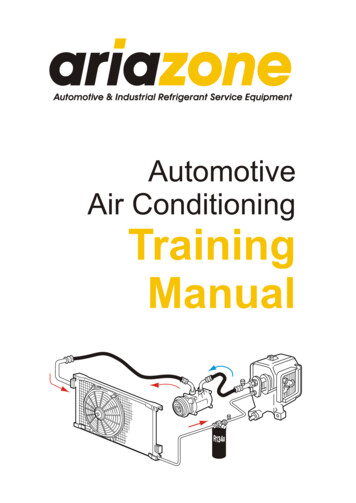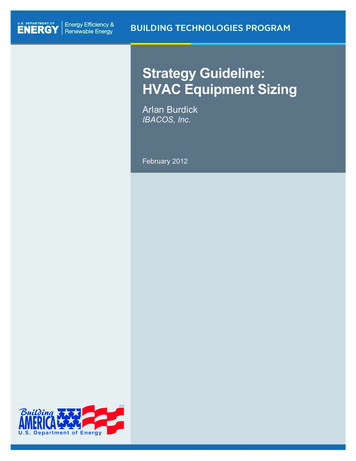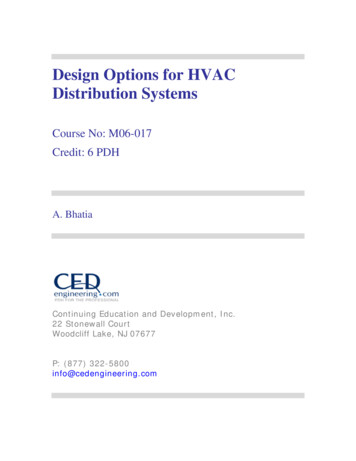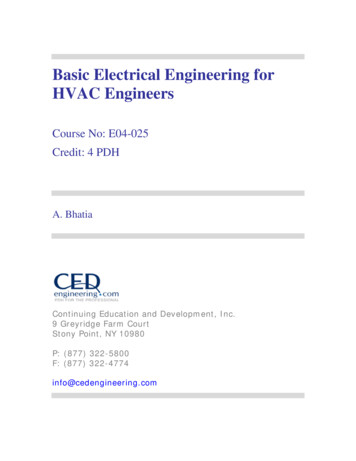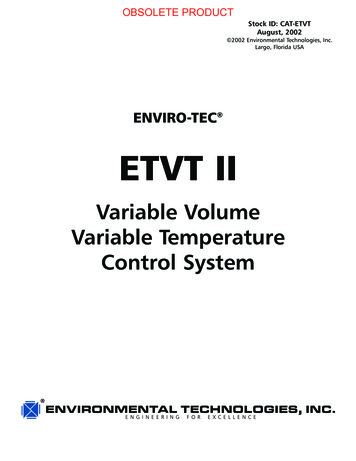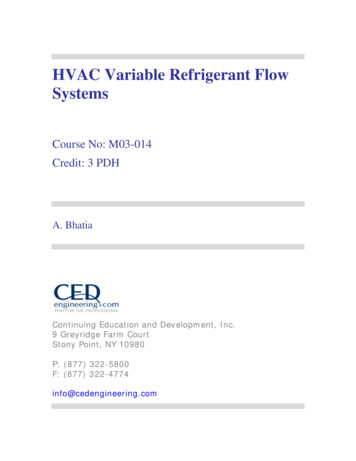
Transcription
HVAC Variable Refrigerant FlowSystemsCourse No: M03-014Credit: 3 PDHA. BhatiaContinuing Education and Development, Inc.9 Greyridge Farm CourtStony Point, NY 10980P: (877) 322-5800F: (877) 322-4774info@cedengineering.com
Variable Refrigerant Flow (VRF) SystemsVariable refrigerant flow (VRF) is an air-condition system configuration where there isone outdoor condensing unit and multiple indoor units. The term variable refrigerant flowrefers to the ability of the system to control the amount of refrigerant flowing to themultiple evaporators (indoor units), enabling the use of many evaporators of differingcapacities and configurations connected to a single condensing unit. The arrangementprovides an individualized comfort control, and simultaneous heating and cooling indifferent zones.Currently widely applied in large buildings especially in Japan and Europe, thesesystems are just starting to be introduced in the U.S. The VRF technology/system wasdeveloped and designed by Daikin Industries, Japan who named and protected the termvariable refrigerant volume (VRV) system so other manufacturers use the term VRF"variable refrigerant flow". In essence both are same.With a higher efficiency and increased controllability, the VRF system can help achieve asustainable design. Unfortunately, the design of VRF systems is more complicated andrequires additional work compared to designing a conventional direct expansion (DX)system.This course provides an overview of VRF system technology.
OVERVIEW OF VRF SYSTEMSThe primary function of all air-conditioning systems is to provide thermal comfort forbuilding occupants. There are a wide range of air conditioning systems available,starting from the basic window-fitted units to the small split systems, to the medium scalepackage units, to the large chilled water systems, and currently to the variable refrigerantflow (VRF) systems.The term VRF refers to the ability of the system to control the amount of refrigerantflowing to each of the evaporators, enabling the use of many evaporators of differingcapacities and configurations, individualized comfort control, simultaneous heating andcooling in different zones, and heat recovery from one zone to another. VRF systemsoperate on the direct expansion (DX) principle meaning that heat is transferred to orfrom the space directly by circulating refrigerant to evaporators located near or within theconditioned space. Refrigerant flow control is the key to many advantages as well as themajor technical challenge of VRF systems.Note the term VRF systems should not be confused with the centralized VAV (variableair volume) systems, which work by varying the air flow to the conditioned space basedon variation in room loads.Split Air-conditioning SystemsSplit type air conditioning systems are one-to- one systems consisting of one evaporator(fan coil) unit connected to an external condensing unit. Both the indoor and outdoorunits are connected through copper tubing and electrical cabling.The indoor part (evaporator) pulls heat out from the surrounding air while the outdoorcondensing unit transfers the heat into the environment.
Split Air-conditioning SystemAdvantages of using Split Air-conditioners Low initial cost, less noise and ease of installation; Good alternative to ducted systems; Each system is totally independent and has its own control.Disadvantages There is limitation on the distance between the indoor and outdoor unit i.e.refrigerant piping can’t exceed the limits stipulated by the manufacturer (usually100 to 150 ft) otherwise the performance will suffer; Maintenance (cleaning/change of filters) is within the occupied space; Limited air throw which can lead to possible hot/cold spots; Impact on building aesthetics of large building because too many outdoor unitswill spoil the appearance of the building.Multi-Split SystemsA multi-type air conditioning system operates on the same principles as a split type airconditioning system however in this case there are ‘multiple’ evaporator units connectedto one external condensing unit. These simple systems were designed mainly for smallto medium commercial applications where the installation of ductwork was either too
expensive, or aesthetically unacceptable. The small-bore refrigerant piping, whichconnects the indoor and outdoor units requires much lower space and is easier to installthan the metal ducting. Each indoor unit has its own set of refrigerant pipe workconnecting it to the outdoor unit.Advantages of Multi-splits The fact that one large condenser can be connected to multiple evaporatorswithin the building reduces and/or eliminates the need for ductwork installationcompletely. Multi-splits are suitable for single thermal zone (defined below) applications withvery similar heat gains/losses.Drawbacks Inability to provide individual control;
Multi-split systems turn OFF or ON completely in response to a singlethermostat/control station which operates the whole system. These systems aretherefore not suitable for areas/rooms with variable heat gain/loss characteristics.(Thermal zone: A thermal zone is referred to a space or group of spaces within abuilding with similar heating and cooling requirements. Each thermal zone must be‘separately controlled’ if conditions conducive to comfort are to be provided by an HVACsystem.)Any area that requires different temperature, humidity and filtration needs shall becategorized as an independent zone and shall be controlled by dedicated control orHVAC system. Few examples below illustrate and clarify the zone concept: A conference room designed for 50 people occupancy shall experience lowertemperatures when it is half or quarterly occupied. Thus, the design shouldinclude a provision for a dedicated temperature controller for this zone; A smoking lounge of airport has different filtration, ventilation (air changes) andpressure requirement compared to other areas; therefore, it is considered aseparate zone; A hotel lobby area is different from the guest rooms or the restaurant areabecause of occupancy variations; In a commercial building, the space containing data processing equipment suchas servers, photocopiers, fax machines and printers are exposed to much largerheat load than the other areas; and hence, it is a different thermal zone; A hospital testing laboratory, isolation rooms and operation theatre demanddifferent indoor conditions/pressure relationships than the rest of areas; and thus,shall be treated as a separate zones; A control room or processing facility in industrial set up may require a highdegree of cleanliness/positive pressure to prevent ingress of dust/hazardouselements, and therefore, it may be treated as separate zone.
Variable Refrigerant Flow or VRF SystemsVRF systems are similar to the multi-split systems which connect one outdoor section toseveral evaporators. However, multi-split systems turn OFF or ON completely inresponse to one master controller, whereas VRF systems continually adjust the flow ofrefrigerant to each indoor evaporator. The control is achieved by continually varying theflow of refrigerant through a pulse modulating valve (PMV) whose opening is determinedby the microprocessor receiving information from the thermistor sensors in each indoorunit. The indoor units are linked by a control wire to the outdoor unit which responds tothe demand from the indoor units by varying its compressor speed to match the totalcooling and/or heating requirements.VRF systems promise a more energy-efficient strategy (estimates range from 11% to17% less energy compared to conventional units) at a somewhat higher cost.The modern VRF technology uses an inverter-driven scroll compressor and permits asmany as 48 or more indoor units to operate from one outdoor unit (varies frommanufacturer to manufacturer). The inverter scroll compressors are capable of changing
the speed to follow the variations in the total cooling/heating load as determined by thesuction gas pressure measured on the condensing unit. The capacity control range canbe as low as 6% to 100%.Refrigerant piping runs of more than 200 ft are possible, and outdoor units are availablein sizes up to 240,000 Btuh.A schematic VRF arrangement is indicated below:Figure (Source: Fujitsu)VRF systems are engineered systems and use complex refrigerant and oil controlcircuitry. The refrigerant pipe-work uses a number of separation tubes and/or headers(refer schematic figure above).A separation tube has 2 branches whereas a header has more than 2 branches. Eitherof the separation tube or header, or both, can be used for branches. However, theseparation tube is NEVER provided after the header because of balancing issues.
Compared to multi-split systems, VRF systems minimize the refrigerant path and useless copper tubing. Minimizing the refrigerant path allows for maximizing the efficiencyof refrigerant work.
Types of VRFVRV/VRF systems can be used for cooling only, heat pumping or heat recovery. On heatpump models there are two basic types of VRF system: heat pump systems and energyrecovery.VRF heat pump systemsVRF heat pump systems permit heating or cooling in all of the indoor units but NOTsimultaneous heating and cooling. When the indoor units are in the cooling mode, theyact as evaporators; when they are in the heating mode, they act as condensers. Theseare also known as two-pipe systems.Cooling Type VRF SystemFigure (Source: Fujitsu)VRF heat pump systems are effectively applied in open plan areas, retail stores, cellularoffices and any other area that require cooling or heating during the same operationalperiods.
Heat Recovery VRF system (VRF-HR)Variable refrigerant flow systems with heat recovery (VRF-HR) capability can operatesimultaneously in heating and/or cooling mode, enabling heat to be used rather thanrejected as it would be in traditional heat pump systems. VRF-HR systems are equippedwith enhanced features like inverter drives, pulse modulating electronic expansionvalves and distributed controls that allow system to operate in net heating or net coolingmode, as demanded by the space.Each manufacturer has its own proprietary design (2-pipe or 3-pipe system), but mostuses a three-pipe system (liquid line, a hot gas line and a suction line) and specialvalving arrangements. Each indoor unit is branched off from the 3 pipes using solenoidvalves. An indoor unit requiring cooling will open its liquid line and suction line valvesand act as an evaporator. An indoor unit requiring heating will open its hot gas and liquidline valves and will act as a condenser.Typically, extra heat exchangers in distribution boxes are used to transfer some rejectheat from the superheated refrigerant exiting the zone being cooled to the refrigerantthat is going to the zone to be heated. This balancing act has the potential to producesignificant energy savings.Heat Recovery Type VRF System - Figure (Source: Fujitsu)
VRF-HR mixed mode operation leads to energy savings as both ends of thethermodynamic cycle are delivering useful heat exchange. If a system has a coolingCOP (Coefficient of Performance) of 3, and a heating COP of 4, then heat recoveryoperation could yield a COP as high as 7. It should be noted that this perfect balance ofheating and cooling demand is unlikely to occur for many hours each year, but whenevermixed mode is used energy is saved. Units are now available to deliver the heatremoved from space cooling into hot water for space heating, domestic hot water orleisure applications, so that mixed mode is utilized for more of the year.VRF-HR systems work best when there is a need for some of the spaces to be cooledand some of them to be heated during the same period. This often occurs in the winter inmedium-sized to large sized buildings with a substantial core or in the areas on the northand south sides of a building.The Coefficient of Performance (COP) is the performance rating used primarily in heatpumps. It is defined as the ratio of heat output to the amount of energy input of a heatpump. It compares the heat produced by the heat pump to the heat obtained fromresistance heat. COPs vary with the outside temperature; as the temperature falls theCOP falls also since the heat pump is less efficient at lower temperatures. ARI standardscompare equipment at two temperatures, 47 F and 17 F, to give you an idea of the COPin both mild and colder temperatures.Refrigerant Modulation in a VRF SystemVRV/VRF technology is based on the simple vapor compression cycle (same asconventional split air conditioning systems) but gives you the ability to continuouslycontrol and adjust the flow of refrigerant to different internal units, depending on theheating and cooling needs of each area of the building. The refrigerant flow to eachevaporator is adjusted precisely through a pulse wave electronic expansion valve inconjunction with an inverter and multiple compressors of varying capacity, in response tochanges in the cooling or heating requirement within the air conditioned space.We will discuss this further but before that let’s refresh the basic refrigeration cycle.
The fundamental of an air conditioning system is the use of a refrigerant to absorb heatfrom the indoor environment and transfer it to the external environment. In the coolingmode, indoor units are supplied with liquid refrigerant. The amount of refrigerant flowingthrough the unit is controlled via an expansion valve located inside the unit. When therefrigerant enters the coil, it undergoes a phase change (evaporation) that extracts heatfrom the space, thereby cooling the room. The heat extracted from the space isexhausted to the ambient air.Refrigeration systems can operate on reverse cycle mode with an inclusion of special 4way reversing valve, enabling the absorption of heat from the external environment andusing this heat to raise the internal temperature. When in the heating mode, indoor unitsare supplied with a hot gas refrigerant. Again, the amount of hot gas flowing through theunit is controlled via the same electronic expansion valve. As with the liquid refrigerant,the hot gas undergoes a phase change (condensation), which releases heat energy intothe space. These are called heat pump systems. Heat pumps provide both heating andcooling from the same unit and due to added heat of compression, the efficiency of aheat pump in the heating mode is higher compared to the cooling cycle.Expansion valve is the component that controls the rate at which liquid refrigerant canflow into an evaporator coil. The conventional refrigeration cycle uses “thermostaticexpansion valve (TXV)” that uses mechanical spring for control. It has its drawbacks. TXV operation is totally independent of compressor operation;
TXV is susceptible to hunting, i.e. overfeeding and starvation of refrigerant flow tothe evaporator.As the evaporator load increases, available refrigerant will boil off more rapidly. If it iscompletely evaporated prior to exiting the evaporator, the vapor will continue to absorbheat (superheat). Although superheating ensures total evaporation of the liquidrefrigerant before it goes into the compressor, the density of vapor which quits theevaporator and enters the compressor is reduced leading to reduced refrigerationcapacity. The inadequate or high super heat in a system is a concern. Too little: liquid refrigerant entering a compressor washes out the oil causingpremature failure. Too much: valuable evaporator space is wasted and possibly causingcompressor overheating problems.The shortcomings of TXV are offset by the modern electronic expansion valve.Electronic Expansion Valve (EEV)With an electronic expansion valve (EEV), you can tell the system what superheat youwant and it will set it up. The primary characteristic of EEV is its ability to rotate aprescribed small angle (step) in response to each control pulse applied to its windings.EEV consists of a synchronous electronic motor that can divide a full rotation into a largenumber of steps, 500 steps/rev. With such a wide range, an EEV valve can go from fullopen to totally closed and closes down when system is satisfied.EEV in a VRF system functions to maintain the pressure differential and also distributethe precise amount of refrigerant to each indoor unit. It allows for the fine control of therefrigerant to the evaporators and can reduce or stop the flow of refrigerant to theindividual evaporator unit while meeting the targeted superheat.Design Considerations for VRF SystemsDeciding what HVAC system best suits your application will depend on several variablessuch as building characteristics; cooling and heating load requirements; peak
occurrence; simultaneous heating and cooling requirements; fresh air needs;accessibility requirements; minimum and maximum outdoor temperatures; sustainability;and acoustic characteristics.Building CharacteristicsVRF systems are typically distributed systems – the outdoor unit is kept at a far offlocation like the top of the building or remotely at grade level and all the evaporator unitsare installed at various locations inside the building. Typically the refrigerant pipe-work(liquid and suction lines) is very long, running in several hundred of feet in length forlarge multi-story buildings. Obviously, the long pipe lengths will introduce pressurelosses in the suction line and, unless the correct diameter of pipe is selected, the indoorunits will be starved of refrigerant resulting in insufficient cooling to the end user. So it isvery important to make sure that the pipe sizing is done properly, both for the mainheader pipe as well as the feeder pipes that feed each indoor unit.The maximum allowable length varies among different manufacturers; however thegeneral guidelines are as follows: The maximum allowable vertical distance between an outdoor unit and itsfarthest indoor unit is 164 ft; The maximum permissible vertical distance between two individual indoor units is49 feet, The maximum overall refrigerant piping lengths between outdoor and the farthestindoor unit is up to 541 ft.Note: The longer the lengths of refrigerant pipes, the more expensive the initial andoperating costs.
Figure Source: ASHRAEAs stated, the refrigerant piping criteria varies from manufacturer to manufacture; forexample for one of the Japanese manufacturer (Fujitsu), the system design limits are:Source: Fujitsu
L1: Maximum height difference between outdoor unit and indoor unit 50m L2: Maximum height difference between indoor unit and indoor unit 15m L3: Maximum piping length from outdoor unit to first separation tube 70m [L3 L4 L5 L6]: Maximum piping length from outdoor unit to last indoor unit 100m L6 & L7: Maximum piping length from header to indoor unit 40m Total piping length 200m (Liquid pipe length)Building Load ProfileWhen selecting a VRF system for a new or retrofit application, the following assessmenttasks should be carried out: Determine the functional and operational requirements by assessing the coolingload and load profiles including location, hours of operation, number/type ofoccupants, equipment being used, etc. Determine the required system configuration in terms of the number of indoorunits and the outdoor condensing unit capacity by taking into account the yandmaintenanceconsiderationsBuilding a load profile helps determine the outdoor condensing unit compressorcapacity. For instance, if there are many hours at low load, it is advantageous to installmultiple compressors with at least one with inverter (speed adjustment) feature. Thefigure below shows a typical load profile for an office building.
The combined cooling capacity of the indoor sections can match, exceed, or be lowerthan the capacity of the outdoor section connected to them. But as a normal practice: The indoor units are typically sized and selected based on the greater of theheating or cooling loads in the zone it serves, i.e. maximum peak load expectedin any time of the year. The outdoor condensing unit is selected based on the load profile of the facilitywhich is the peak load of all the zones combined at any one given time. Theimportant thing here is that it is unlikely that all zones will peak at a given time soan element of diversity is considered for economic sizing. Adding up the peakload for each indoor unit and using that total number to size the outdoor unit willresult in an unnecessarily oversized condensing unit. Although an oversizedcondensing unit with multiple compressors is capable of operating at lowercapacity, too much over sizing sometimes reduces or ceases the modulationfunction of the expansion valve. As a rule of thumb, an engineer can specify anoutdoor unit with a capacity anywhere between 70% and 130% of the combinedcapacities of the indoor units.Example:Given a commercial office building with 3 zones. Zone #1 has a peak load of 3 tons,Zone #2 has a peak load of 6 tons and Zone #3 has a peak load of 7 tons.Combined zone load 3 6 7 16 tons
Building Peak load 12 tonsNearest available sizes for outdoor units are 12.5 tons and 15 tonsSelect an outdoor condensing unit of 12.5 tonsSustainabilityOne attractive feature of the VRF system is its higher efficiency compared toconventional units. Cooling power in a VRF system is regulated by means of adjustingthe rotation speed of the compressor which can generate an energy saving around 30%.A VRF system permits easy future expansion when the conditions demand. Oversizinghowever, should be avoided unless a future expansion is planned.Other sustainability factors include: Use of non-ozone depleting environment-friendly refrigerants such as R-410a. Opting for heat pump instead of electrical resistance heating in areas demandingboth cooling and heating. Heat pumps offer higher energy efficiency.
Simultaneous Heating and CoolingSome manufacturers offer a VRF system with heat recovery feature which is capable ofproviding simultaneous heating and cooling. The cost of a VRF-HR is higher than that ofa normal VRF heat pump unit and therefore its application should be carefully evaluated.More economical design can sometimes be achieved by combining zones with similarheating or cooling requirements together. For example, the areas that may requiresimultaneous heating and cooling are the perimetric and interior zones. Perimetric areaswith lot of glazing and exposure especially towards west and south will have high loadvariations. A VRF heat pump type system is capable of providing simultaneous heatingand cooling exceeding 6 tons cooling requirement.Using VRF heat pump units for heating and cooling can increase building energyefficiency. The designer must evaluate the heat output for the units at the outdoor designtemperature. Supplemental heating with electric resistors shall be considered only whenthe heating capacity of the VRF units is below the heating capacity required by theapplication. Even though supplemental heating is considered, the sequence of operationand commissioning must specify and prevent premature activation of supplementalheating.First CostsThe installed cost of a VRF system is highly variable, project dependent, and difficult topin down. Studies indicate that the total installed cost of a VRF system is estimated to be5% to 20% higher than air or water cooled chilled water system, water source heatpump, or rooftop DX system providing equivalent capacity. This is mainly due to longrefrigerant piping and multiple indoor evaporator exchanges with associated controls.Building owners often have no incentive to accept higher first costs, even if the claimedpayback period is short, as the energy savings claims are highly unpredictable.VRF ADVANTAGESComfort The main advantage of a variable refrigerant flow system is its ability to respondindividually to fluctuations in space load conditions. The user can set the ambient
temperature of each room as per his/her requirements and the system willautomatically adjust the refrigerant flow to suit the requirement; VRF systems enable wide capacity modulation and bring rooms to the desiredtemperature extremely quickly and keep temperature fluctuations to minimum.The technology offers excellent dehumidification performance for optimal roomhumidity regardless of outside conditions. Any area in the building will always beexactly at the right temperature and humidity, ensuring total comfort for theiroccupants; VRF systems are capable of simultaneous cooling and heating. Each individualindoor unit can be controlled by a programmable thermostat. Most VRFmanufacturers offer a centralized control option, which enables the user tomonitor and control the entire system from a single location or via the internet; VRF systems can generate separate billing that makes individualized billingeasier; VRF systems use variable speed compressors (inverter technology) with 10 to100% capacity range that provides unmatched flexibility for zoning to saveenergy. Use of inverter technology can maintain precise temperature control,generally within 1 F.
Design Flexibility A single condensing unit can be connected to wide range of indoor units ofvarying capacity (e.g., 0.5 to 4 tons ducted or ductless configurations such asceiling recessed, wall-mounted and floor console). Current products enable up to48 indoor units to be supplied by a single condensing unit; The modular concept makes it easy to adapt the HVAC system to expansion orreconfiguration of the space. A VRF system can start functioning even while thebuilding/house is still being constructed; unlike large duct or chiller systemswhich cannot function until the construction project is completed; Suitable for putting an outdoor unit on each floor or in mechanical rooms.Flexible Installation VRF systems enable floor by floor installation and commissioning; VRF systems are lightweight; require less outdoor plant space and offer spacesaving features; It is less disruptive to fit in existing buildings (particularly when occupied) and itsmodular format lends itself to phased installations. A range of system controllersolutions allows the end-user to select the controller that best suits them; It is modular and self contained. A multiple of these units can be installed toachieve cooling capacities of hundreds of tons;
Because ductwork is required only for the ventilation system, it can be smallerthan the ducting in standard ducted systems; thereby, reducing building heightand costs; When compared to the single split system, a VRF system reduces installationcost by about 30%. A VRF system provides reduction in copper tubing and wiringcosts.Energy Efficiency VRF systems benefits from the advantages of linear step control in conjunctionwith inverter and constant speed compressor combination, which allows moreprecise control of the necessary refrigerant circulation amount required accordingto the system load. The inverter technology reacts to indoor and ptionandadjustingcompressor speed to its optimal energy usage. Inverter provides superior energyefficiency performance and also allows for a comfortable environment by use ofsmooth capacity control. Field testing has indicated that this technology canreduce the energy consumption by as much as 30 to 40% a year compared totraditional rotary or reciprocating type compressors. VRF technology yields exceptional part-load efficiency. Since most HVACsystems spend most of their operating hours between 30-70% of their maximumcapacity, where the coefficient of performance (COP) of the VRF is very high, theseasonal energy efficiency of these systems is excellent. A VRF system minimizes or eliminates ductwork completely. This reduces theduct losses often estimated to be 10% to 20% of the total airflow in a ductedsystem.
Inverter compressor technology is highly responsive and efficient. The modulararrangement permits staged operation, i.e. Indoor units can easily be turned offin locations requiring no cooling, while the system retains highly efficientoperation. It is possible to include cooling and heating in a single system which avoidsduplicating systems (a reversible heat pump only costs 10% more than a coolingunit). Energy sub-metering with VRF systems is relatively simple and inexpensive byplacing an electric meter on one or a few condensing units. This is a veryimportant feature in the multi-tenant buildings if energy costs are chargedexplicitly to each tenant rather than being hidden in overall leasing costs.Reduced Noise LevelsIndoor and outdoor units are so quiet that they can be placed just about anywhere,providing more flexibility on how to use indoor and outdoor space. Indoor ductlessoperating sound levels are as low as 27dB(A) and ducted units sound levels are as lowas 29dB(A)Outdoor units can even be placed directly under a window and quiet indoor units areperfect in environments that require minimal disruption like schools, places of worship,libraries and more. When compared to the single split system, a VRF system reducesoutside noise levels by almost 5 dB@1m.Figure Source: Fujitsu
ReliabilityContinuous operation is possible even if trouble occurs at an indoor unit.Indoor UnitEach indoor unit is controlled individually on the system network. This allows all indoorunits continue to run unaffected even if trouble should occur at any indoor unit in onesystem.Outdoor UnitContinuous operation is possible even in the event of compressor failure. There is noimmediate system shutdown if trouble occurs in any compressor. The other compressorscan continue to operate on an emergency basis.Maintenance and Commissioning VRF systems with their standardized configurations and sophisticated electroniccontrols are aiming toward near plug-and-play commissioning. Normalmaintenance for a VRF system is similar to that of any DX
HVAC Variable Refrigerant Flow Systems Course No: M03-014 Credit: 3 PDH A. Bhatia Continuing Education and Development, Inc. 9 Greyridge Farm Court Stony Point, NY 10980 P: (877) 322-5800 F: (877) 322-4774 info@cedengineering.com
